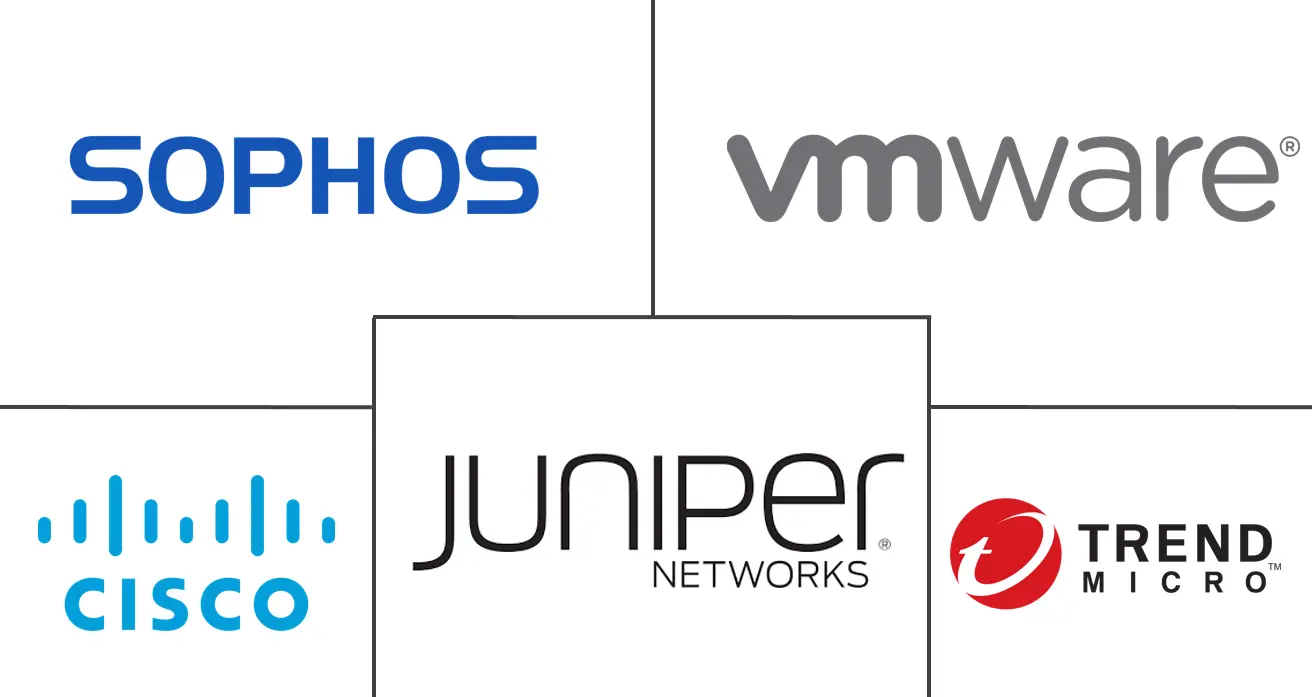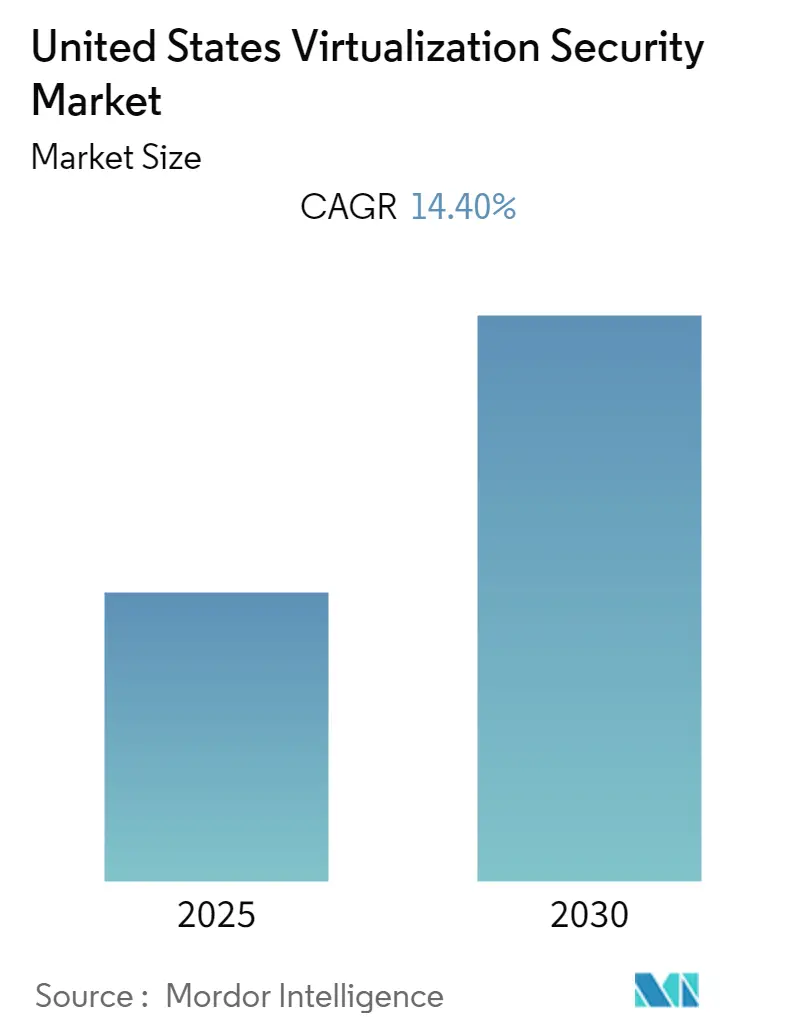
United States Virtualization Security Market Analysis by Mordor Intelligence
The United States Virtualization Security Market is expected to register a CAGR of 14.4% during the forecast period.
- The US market for virtualization security is projected to obtain a massive growth as enterprises are shifting toward cloud and cloud-based technologies as a part of their IT model. In 2019, a survey conducted by Nutanix showed that more than 80% of the respondents prefer cloud-based technologies as an efficient operating model.
- As enterprises move to the virtual environment to modernize their conventional infrastructures, they face numerous security and integration issues that can affect system or server performance as well as costs. When software applications have moved to the wrong virtual environment during migration, it results in decreased software performance if the environment is under-equipped or increased enterprise costs if it is over-equipped.
- As per the report published by the Ponemon Institute and Siemens in October 2019, the utility industry has faced the worsening effect of virtual migration with more than 50% of organizations reporting significant operational data loss or at least one shutdown per year, and more than 25% impacted by mega cyber attacks.
- According to some representatives of FireEye and CrowdStrike, which are regularly tracking malicious web activity, Iran has increased a significant number of offensive cyberattacks against the United States government and critical infrastructure as trade tensions have increased between the two nations. These increasing cyberattacks in the country's government IT infrastructure is expected to drive the demand for virtualization security in the coming years.
- The COVID-19 pandemic has created several exploitation opportunities for advanced persistent threat (APT) groups and cybercriminals. In April 2020, the US Department of Homeland Security (DHS) Cybersecurity and Infrastructure Security Agency (CISA) published a joint alert on the details of security threats in the United States. These government bodies are observing an increasing use of COVID-19-related themes by cybercriminals. Presently, the use of teleworking has increased, such as virtual private networks (VPNs), which therefore amplify the threat to individuals as well as organizations. The increasing cyberattacks at the time of crisis are expected to accentuate the usage of virtualization security solutions by enterprises to get rid of such attacks.
United States Virtualization Security Market Trends and Insights
Cloud Deployment is Expected to Grow at a Significant Rate Throughout the Forecast Period
- The adoption of cloud deployment has been steadily on the rise, not only for smaller companies searching for cost-effective alternatives to physical infrastructure but also in large businesses that want to take advantage of its flexibility. However, at the time of cloud migration, the enterprises are facing major infrastructure security issues.
- Companies, like Amazon Web Services (AWS), have emerged as a significant player in the cloud offerings market landscape. Among the products in the AWS, the Amazon Simple Storage Service (Amazon S3) is one of the infrastructures that has majorly used by companies, like Reddit, Netflix, and Pinterest. Cybercriminals are frequently exploiting Amazon S3 buckets for profit. The Trend Micro’s “Smart Protection Network” infrastructure gave these cloud infrastructures additional insights on the nature of these attacks. For example, in April 2019, it identified a group of cyber attackers who managed to modify some of the content of some websites hosted on AWS.
- Furthermore, in July 2019, Corsa Security launched “Corsa Red Armor,” an end-to-end network virtualization security platform, used to scale traffic inspection to 100%, without lowering performance high-capacity networks.
- Furthermore, enterprises in the country have to abide by some regulatory compliances. One such compliance is the Health Insurance Portability and Accountability Act (HIPAA), which states the rules for healthcare organizations, like nursing homes, hospitals, and private medical companies that deal with critical healthcare data. Such healthcare organizations that run on a hybrid cloud environment are required to ensure that a significant part of their connected cloud environments and the sensitive resources are protected against failing to meet compulsory compliance standards that may lead to data breaches.
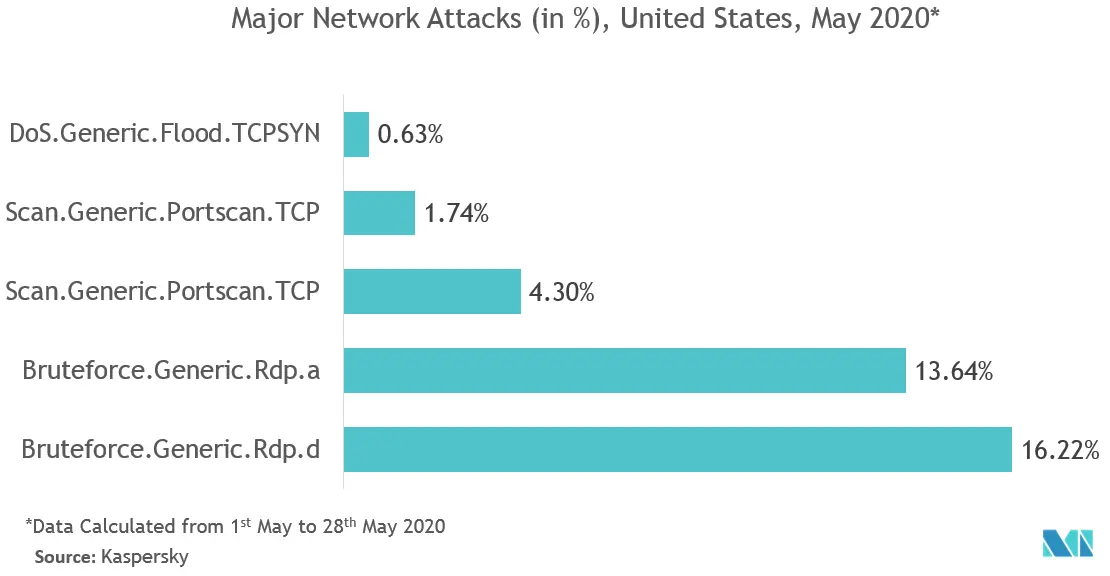
BFSI End-User Segment is Expected to Hold a Significant Share Throughout the Forecast Period
- The BFSI sector is no stranger to virtualization concepts, having already come to take the advantages it offers to satisfy important IT needs, such as centralized information security, improved mobility, and infrastructure disaster recovery capability. Tech giants like Microsoft’s NVv4 solutions for Microsoft Azure have the potential to expand the BFSI use cases, and opportunities to use VMs to support finance operations.
- In May 2020, VMware Inc. released the third annual “Modern Bank Heists” report, which is produced by VMware Carbon Black. The report includes VMware Carbon Black cyber threat data analysis and annual survey results featuring responses from major financial institution CISOs. As per the report, from February to April 2020, attacks targeting the BFSI sector of the country have doubled, and the Ransomware attacks in the financial industry have increased by more than five times.
- In November 2019, IBM focused on targeting financial service customers with the development of a financial services-ready cloud platform in collaboration with the Bank of America. The Bank of America is expected to use the platform and host critical applications to support its more than 60 million banking customers. These virtual infrastructure adoptions by the BFSI players will drive the growth of virtualization security solutions in this end-user segment.
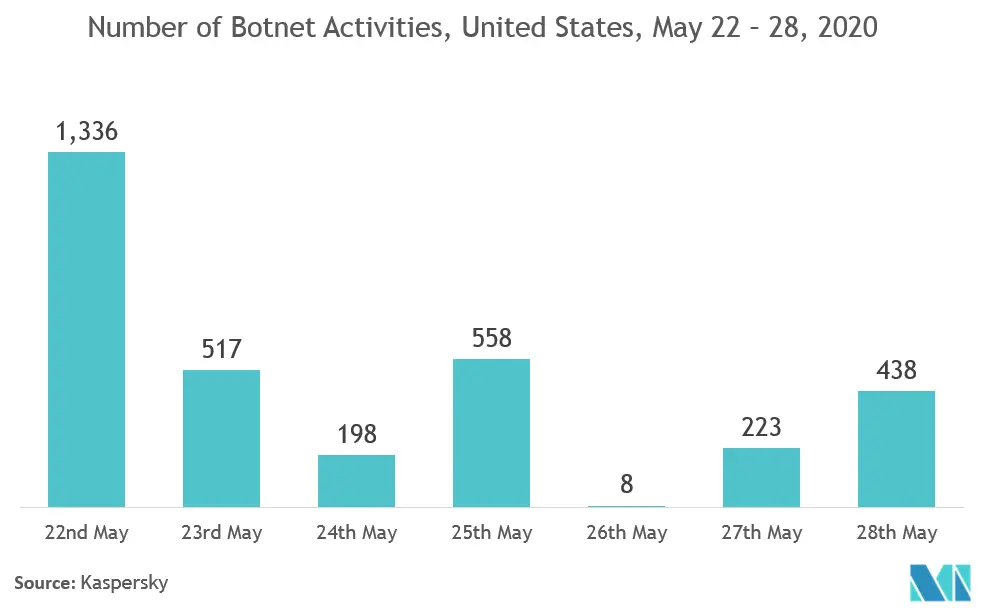
Competitive Landscape
The United States virtualization security market is dominated by players, like VMware, Sophos Ltd., and Cisco Systems, which provide virtualization security solutions used by major end-user enterprises. The players operating in the country account for a significant share in the market and focusing on expanding their customer base. These players are primarily focusing on investment in developing new solutions, strategic collaborations, and other organic and inorganic growth strategies to earn a competitive edge during the forecast period.
- In May 2020, VMware Inc advanced its intrinsic security strategy at 'Connect 2020' by announcing an intent to acquire Octarine to broaden the workload security portfolio. Octarine's innovative security platform helps to simplify DevSecOps from development through runtime in the virtual environment.
- In February 2020, Sophos introduced XG Firewall v18 with the Xstream architecture, which gives improved visibility, protection, and performance of endpoint security of an IT infrastructure. The addition of the XG Firewall to the Intercept X endpoint protection offers synchronized security. The company has managed the whole architecture from the Sophos Central cloud console in real-time, which will increase the efficiency of resolving security issues.
United States Virtualization Security Industry Leaders
-
VMware Inc.
-
Trend Micro Incorporated
-
Cisco Systems, Inc.
-
Juniper Networks, Inc.
-
Sophos Ltd.
- *Disclaimer: Major Players sorted in no particular order
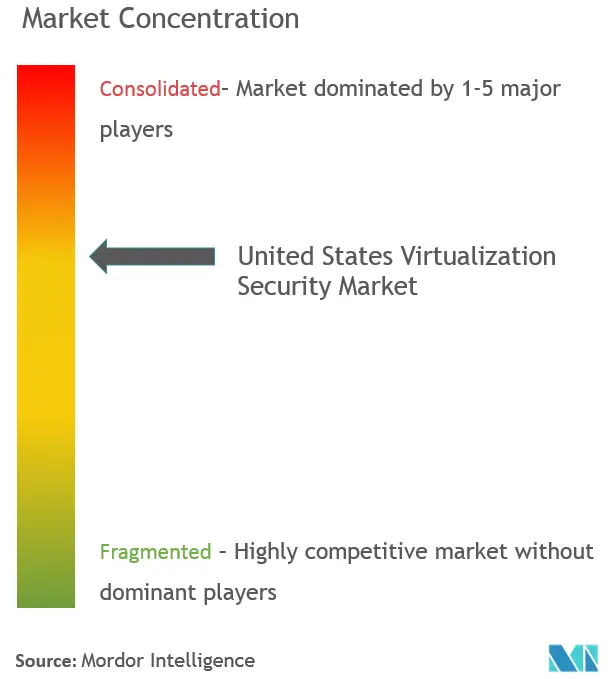
United States Virtualization Security Market Report Scope
The US virtualization security market study focuses on the country's critical virtual infrastructure security ecosystem. The study tracks down the usage of different virtualization types, components, deployment methods, and types of virtual infrastructure used by various end-users. The study also focuses on analyzing the existing competitive landscape, which consists of major players and their offerings across the country's scope.
| Hardware Virtualization |
| Software Virtualization |
| Solutions |
| Services |
| On-Premise |
| Cloud |
| Hypervisor |
| Virtual Machines |
| Web Servers |
| Other Type of Virtual Infrastructures |
| IT and Telecom |
| Cloud Service Providers |
| Data Centers |
| BFSI |
| Healthcare |
| Government |
| Other End Users |
| Virtualization Type | Hardware Virtualization |
| Software Virtualization | |
| Component | Solutions |
| Services | |
| Deployment | On-Premise |
| Cloud | |
| Type of Virtual Infrastructure | Hypervisor |
| Virtual Machines | |
| Web Servers | |
| Other Type of Virtual Infrastructures | |
| End User | IT and Telecom |
| Cloud Service Providers | |
| Data Centers | |
| BFSI | |
| Healthcare | |
| Government | |
| Other End Users |
Key Questions Answered in the Report
What is the current United States Virtualization Security Market size?
The United States Virtualization Security Market is projected to register a CAGR of 14.4% during the forecast period (2025-2030)
Who are the key players in United States Virtualization Security Market?
VMware Inc., Trend Micro Incorporated, Cisco Systems, Inc., Juniper Networks, Inc. and Sophos Ltd. are the major companies operating in the United States Virtualization Security Market.
What years does this United States Virtualization Security Market cover?
The report covers the United States Virtualization Security Market historical market size for years: 2019, 2020, 2021, 2022, 2023 and 2024. The report also forecasts the United States Virtualization Security Market size for years: 2025, 2026, 2027, 2028, 2029 and 2030.
Page last updated on:
United States Virtualization Security Market Report
Statistics for the 2025 United States Virtualization Security market share, size and revenue growth rate, created by Mordor Intelligence™ Industry Reports. United States Virtualization Security analysis includes a market forecast outlook for 2025 to 2030 and historical overview. Get a sample of this industry analysis as a free report PDF download.
